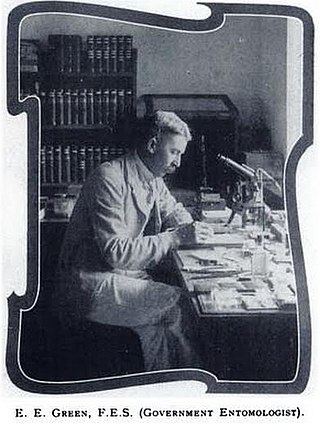
Henry George Percy, 7th Duke of Northumberland,, styled Lord Warkworth between 1865 and 1867 and Earl Percy between 1867 and 1899, was a British Conservative politician. He served as Treasurer of the Household under Benjamin Disraeli between 1874 and 1875 and was Chairman of the National Union of Conservative and Constitutional Associations from 1879 to 1883.
Colonel Lord Algernon Malcolm Arthur Percy was a British career soldier and Conservative politician who sat in the House of Commons from 1882 to 1887.

Edward Ernest Green was an Ceylon-born English mycologist and entomologist who specialised in the scale-insects, Coccidae. An accomplished artist, and lithographer, he illustrated the five volume Coccidae of Ceylon.
Sir Thomas Lister Villiers was a British planter in Ceylon. He was appointed the European unofficial member of the Legislative Council of Ceylon from 1924 to 1931, appointed member of the State Council of Ceylon (1932) and chairman of George Steuart Group.
Victor Garvin Weerawardana Ratnayake MBE was a Sri Lankan tea planter and politician.
Major John William Oldfield, was a prominent figure in the commercial and public life in Ceylon, serving as the chairman of the Ceylon Planters' Association between 1924 and 1925, an appointed member of the State Council of Ceylon in 1931 and as an appointed member of the first Parliament of Ceylon in 1947.
George Roland Whitby was a British tea planter, businessman and a member of parliament.
Francis Huntly Griffith JP, UM was a tea and rubber planter in Ceylon and a member of parliament.

Robert Singleton Salmon, was a British tea planter, businessman and a member of parliament.
Reginald Percy Gaddum was a tea planter in Ceylon and a member of parliament from 1952 to 1956.
Richard Charles Kannangara was a Ceylonese tea plantation owner and politician.
Evelyn Charles Arthur Villiers JP UPM was a British planter and politician in colonial Ceylon.
Howard Frank Parfitt was a British tea planter, businessman and politician in colonial Ceylon.
Thomas Edward Barnes Skinner was the Postmaster General of Ceylon, between 1871 and 1896.
Arthur Sampson Pagden CMG was an English civil servant, who was employed in the Ceylon Civil Service for forty years, between 1881 and 1920. During which time was elected as the Mayor of Colombo (1901-1905) and appointed as the Principal Assistant Colonial Secretary (1905-1906), the Postmaster General of Ceylon (1906-1913) and the Controller of Revenue (1913-1920).

Sir William Duff Gibbon was a British Ceylonese tea planter and politician.
Gate Mudaliyar Naganather Canaganayagam, CBE, JP, FREconS was a Ceylonese banker, planter and local politician, who served as the first Tamil Mayor of Kandy in 1942.
Allan Morley Spaar MBE JP was a Ceylonese public servant and local politician, serving as the second Mayor of Kandy between 1940 and 1942.
Leonard William Booth was a British civil servant, who served in Ceylon and was the acting Colonial Secretary of Ceylon from 1911 to 1913.




